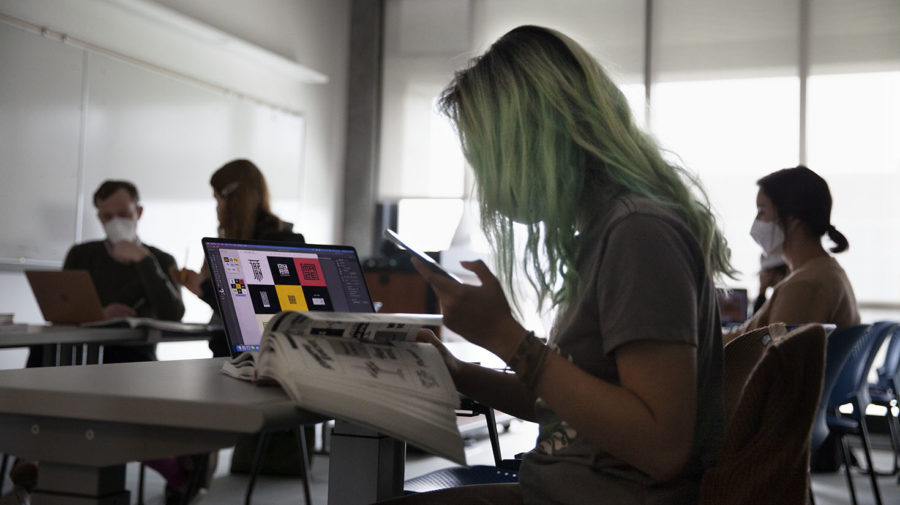City College’s graphic design program sets sights on bachelor’s degree (with video)
Professor Sean Bacon considers the program a way to provide a usually costly education at an accessible price
Graphic design student Nhi Tat (foreground) works on her class project while Professor Sean Bacon holds an individual consultation with student Ksenia LaRusse during advanced typography class at San Diego City College on March 16. Fellow student Skyler Lingo (right) listens in on Bacon’s comments. City’s graphic design program has been recognized as the sixth-best Design Education Institution of 2021-2022 by the World Brand Design Society. Photo by Philip Salata/City Times Media
March 17, 2022
Correction: An earlier version of this piece incorrectly stated Pasadena’s ArtCenter College of Design charged $24,471 per year, when that is actually the cost per term. City Times regrets the error.
This piece is part of an ongoing series regarding the passage of AB-927, which allows 30 California community colleges a year to create bachelor’s degree programs. The following showcases a potential candidate program at San Diego City College.
Tiffany Hohmann recently graduated from San Diego City College with an Associate of Arts in Graphic Design, but she returned to take some classes for “funsies.”
Despite her love for the program, and the success that City graphic design professor Sean Bacon said he’s had with matching graduates with employers, it became clear to Hohmann that she would need to pursue a bachelor’s degree in order to be seriously considered for employment at many workplaces.
Hohmann said she went through with the application process anyway. She got to the third interview for one job, and the fourth for another, which included a test assignment.
“But at the end of the day, both of them said we want someone who has more education,” she said. “It’s a super bummer when you can tell they like you and they like your work, but they need this piece of paper.”
Hohmann’s experience seems to be a tidy demonstration of one of the stipulations AB-927 puts on community colleges, which requires evidence that, “employers are willing to pay baccalaureate degree holders more than those with a related associate degree or no postsecondary degree.”
So Hohmann, who’s the first in her family to go to college and has thus far been able to take advantage of programs that allow for reduced tuition while attending City, has decided to transfer to an arts-focused school to finish her education.
It is a move she knows will drive up the price she’ll pay.
Tuition for the two programs that interest Hohmann total an estimated $40,000 a year.
“When I transfer, 100% I will be taking out loans and I’ll become a student loan statistic,” she said.
That is part of why Bacon, himself a City alum, has set his sights on creating a bachelor’s degree within City’s graphic design program.
“In my industry in particular, education is extremely expensive,” Bacon said.
Rhode Island School of Design, a top-rated graphic design college, charges $56,435 annually for undergraduate tuition. And Pasadena’s ArtCenter College of Design, another highly rated program, charges $24,471 per term.
“That just creates a lot of barriers, and then if you look at the racial demographics of our industry, they’re skewed extremely white,” Bacon said.

Bacon sees City’s AA program as something of an equalizer, bringing high-quality education to students for a fraction of the cost of four-year programs. According to him, students can earn City’s graphic design AA for around $2,000.
For Bacon, part of preparing students is creating lines of communication between local employers to ensure students are getting an education that’s up-to-date, valuable and will allow them to easily transition from City into the workplace.
He embraces industry connections and jokes that he’s constantly playing matchmaker with recent graduates and employers looking for candidates with specific skill sets.
“We’re here to help you kind of bridge that gap between academia and employment,” Bacon said.
And the program has garnered recognition.
It was recently rated the sixth-best Design Education Institution of 2021-2022 by the World Brand Design Society, and it boasts well-known graduates like Josh Higgins, former design director for Obama’s re-election campaign, and former global chief creative officer for Meta’s (Facebook) Reality Labs.
https://www.instagram.com/p/CZkSBjdPT11/?utm_medium=copy_link
At City, students learn to use graphic elements such as images and text to effectively communicate ideas. But most importantly, students are guided through the process of developing a professional portfolio, which is a critical aspect of graphic design education.
In the professional world this training can translate to branding, the creation of logos or even interactive app design.
During AB-927’s first biannual submission period, which concluded in January, City submitted a proposal from its cybersecurity program to develop a bachelor’s in Cyber Defense and Analysis.
Bacon hopes to submit a proposal on behalf of the graphic design program during the next application period, which begins in April and ends in August, according to professor David Kennemer, who spearheaded the cybersecurity proposal.
On Mar. 14, City’s instructional cabinet voted to advance the proposal, but Bacon said it still must be approved by the academic senate and college council.
But because of the AB-927 stipulation that newly developed bachelor’s programs can’t be duplicative of any offered by a California State University or University of California school, creating a straightforward graphic design bachelor’s degree isn’t an option.
So Bacon has had to get creative.
“It’ll be very different than what we’re doing right now, and it may not even look like design in the way that we think of it,” Bacon said of the potential degree his program will propose.
Prior to submitting the proposal, he is keeping the details of the potential degree under wraps. But Bacon said Santa Monica College’s Bachelor’s of Science in Interaction Design – which was established under SB-850, the pilot program predecessor to AB-927 – was a big influence on the way his program approached the proposal.
Interaction, or user experience (UX), design is an industry that deals with creating user interface systems for interactive products like apps, devices and websites.
In our increasingly digital world, interaction design, or UX design, represents a rapidly growing industry. The Bureau of Labor Statistics estimates 13% job growth for web developers and digital designers, a rate classified as faster than average.
The BLS also projects median pay to be around $77,000, much higher than the national median earnings of full-time workers, which the 2020 census found to be around $56,000.
Santa Monica College established its degree all the way back in 2015, when interaction design was a less established field, highlighting the way in which community colleges could position themselves to fulfill workforce gaps of the future.
And do so at a significantly less expensive price for students.
Santa Monica’s degree, like all established under AB-927, is required to cost around $10,000 for all four years. Undergraduate tuition for the 2022-23 school year at California College of the Arts, which offers a bachelor’s in interaction design, is $53,856.
“I think the way (Santa Monica) approached it was really smart in terms of needs of the community and jobs, but also doing something that was pretty unique for their own campus,” Bacon said.
But while the workforce needs in tangential areas of graphic design, like UX, are growing at a rapid rate, the job outlook for graphic designers themselves isn’t so rosy. According to BLS data the number of graphic design jobs, which are projected to increase by 3%, is actually growing significantly slower than the 8% growth rate across all occupations.

“We feel that there are opportunities to evolve the education in a way that would be different,” Bacon said.
Whatever the specifics of the degree the graphic design program ends up proposing, Bacon said his goal remains the same – to provide unique and genuinely valuable opportunities for students.
“It’s all fine and dandy to get a program off the ground,” Bacon said, “but if students aren’t getting jobs, if there aren’t outcomes from it that are successful, and there aren’t places in the industry for the students, (the program is) also not very successful either, right?”














